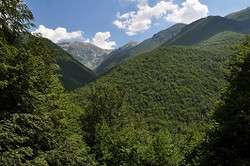Cost effective monitoring to help preserve forest diversity

Protecting genetic diversity is essential to ensuring that European forests have the flexibility to adapt to future environmental conditions and societal demands. A newly developed monitoring protocol designed to assess genetic diversity at the European scale – and fully applicable to different tree species – could bring significant benefits to forest administrations, forest managers and staff from forest research institutes across EU Member States.
Preserving forests is also an economic issue. Forest-based industries represent about 7 % of EU manufacturing GDP, and provide nearly 3.5 million jobs across over 400 thousand companies, most of which are small and medium-sized or micro enterprises. Raw material used by the forest-based industries provides income to around 16 million forest owners in the EU.
'Genetic monitoring means checking temporal changes in the genetic variation and structure of tree populations, in order to assess how well genetic diversity is maintained over time, and how it evolves as a result of climate change and management practices,' explains FORGER project team member Dr Bernd Degen, head of the Institute of Forest Genetics at the von Thünen-Institut, Germany. In a new short film, Degen presents his institute laboratories where tree samples are examined, and reveals the hands-on work behind genetic monitoring.
'We recently completed experimental monitoring work in selected forest plots, and analysis of the data has enabled us to formulate recommendations for an improved protocol for genetic monitoring on a European-wide scale.'
The developed guidelines offer forest managers cost reductions of around 30 % compared with conventional monitoring techniques, through focusing on two rather than three stages of individual tree development (adults, seedlings and saplings) in each plot selected for monitoring. Following completion of the test phase, the protocol will be further evaluated and compared with alternative approaches, within the framework of a new EU-funded project, scheduled to start in early 2016 (GENTREE).
'In Germany, we plan to expand our ongoing genetic monitoring approaches to include the recommendations from the pilot study carried out in FORGER,' adds Degen. 'The objective will continue to develop recommendations for an optimal approach, applicable at a European-wide scale.'
The FORGER project has also produced a range of materials to disseminate its research results to as wide an audience as possible, ranging from factsheets to multimedia products. 'We wanted to have a real impact on the management of forests with our project findings,' says Degen.
Impressive scientific progress has been made in detecting patterns of genetic diversity in recent years, and there has been increased awareness at the policy making level of its economic and environmental importance. What has been missing however has been an efficient EU-wide forest monitoring scheme. The FORGER project has taken steps to fill this gap, and its findings will have a positive knock-on effect in other research areas.
For example, genetic monitoring is an important topic for a current phase of the European Forest Genetic Resource programme (EUFORGEN). 'The development of a system for monitoring genetic diversity will be an invaluable tool for forest protection and sustainable management, which is why this theme has been considered as a priority for this multi-country collaborative programme,' says Degen.
The FORGER project is due for completion in February 2016.
More information: For further information please visit: FORGER project website. www.fp7-forger.eu/
Provided by CORDIS















